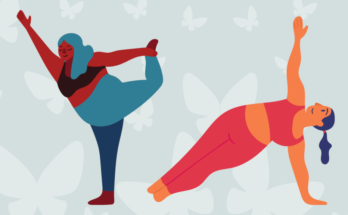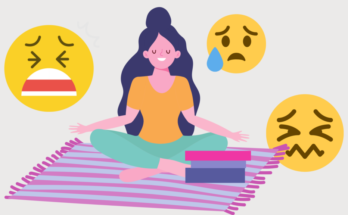✅ Fact Checked
🧘 If you only got 30 seconds:
If you’ve ever taken a yoga class, you probably know that simply taking the time to move your body and breathe can cause a whole surge of emotions. From relaxation to happiness and even feeling more anxiety.
Wondering what’s going on and why yoga makes you feel more joyful/high/nauseous/[insert your option here]?
Here are the top 6 things you might feel during or after your yoga class and why you’re feeling that way, according to science.

1/5 🔋 A Surge Of Energy And Alertness
After you begin practicing yoga you might feel more energetic and alert throughout your day. Sounds counterintuitive? It might, but in fact, regular physical activity and movement will make you feel less tired in the long term.
The reason is that yoga, just like any other movement, improves your blood circulation. The better your blood circulation, the better the oxygen supply is, meaning your cells get nourished with nutrients, and your organs are able to work better and more efficiently.
On top of that, yoga’s physical postures along with stress-relieving breathing practice might improve your sleep quality. Good sleep will make you feel more rested, refreshed, and energetic upon waking up.
My Favorite Yoga Gear Essentials
I’m picky about my yoga gear
I’m ready to blow some cash on high-quality ethically-made items that are eco-friendly and built to last 🌱 It supports my efforts for sustainable yoga practice and lifestyle.
2/5 😌 A Deep Feeling Of Calmness
Taking a soothing bath, drinking tea, listening to your favorite relaxing music – basically, whatever helps you breathe deeper and relax will switch your nervous system into parasympathetic or “rest and digest” mode and calm you down.
Research shows that yoga has the same soothing effect on your brain and nerves as the above activities, encouraging your body to switch from an aroused state triggered by sympathetic activity into stillness and relaxation.
Yoga’s many effects can all be traced back to a common mechanism: the functioning of the vagus nerve, which connects the brain (and therefore the mind) to the body.
The vagus nerve is the main component of the parasympathetic nervous system, which is responsible for feed-and-breed and rest-and-digest processes, as well as regulating heart rate and promoting calmness and relaxation. It runs all the way from the brain to our abdomen, connecting the brain stem to the heart, lung, digestive tract, and kidneys. The vagus nerve also regulates our caring behavior, promoting the feeling of calm, relaxation and safety.
The connection between the vagus nerve and our emotional state is reciprocal: feeling calm, relaxed, and sociable also stimulates the vagus nerve.
Yoga helps you start off a positive upward spiral of calmness by affecting your body and strengthening your vagus nerve (yes, the vagus nerve can be trained like a muscle!), triggering relaxation and soothing your emotional nervous system.

3/5 🤗 Increased Feeling Of Joy And Happiness
Toning and strengthening your vagus nerve isn’t the only yoga superpower. A regular yoga practice can also change your brain activity, spiking your GABA levels – a neurotransmitter responsible for communication between your brain and nervous system.
GABA is specifically important for inhibiting the activity of neurons involved in fear and anxiety. Low levels of GABA have been linked to schizophrenia, depression, anxiety, and sleep disorders. When your brain gets overwhelmed with fear or anxiety, here’s where GABA comes in.
Studies show that those with a regular yoga asana practice display higher GABA levels than the non-yogis. And higher GABA means better mood, more satisfaction from life, and less overall anxiety. What’s more, yoga is more effective at boosting GABA than simply taking a walk or exercising.
Yoga Deals & Discount Codes
Brands I use and love
Here’s a collection of companies and brands I’ve tried and loved ❤️ I’ve grouped them into 4 categories. The brands in each category are sorted alphabetically and include a: short about/best for info, link to my full review, and a discount code (if available).
4/5 🥰 Yoga High And Euphoria
If you leave a yoga class brimming with energy, bliss, and euphoria, congratulations! You’re experiencing a famous “yoga high.”
Yoga highs or buzzes are common after-class experiences. Students describe them as feeling their best all day. Calm yet energized, relaxed yet strong, refreshed with slight pulsations that follow them throughout the day. The yoga high is almost impossible to put into words.
Chemicals and hormones are the main reason you feel so good after a yoga class and get hooked up on getting back on your yoga mat.
Yoga has been shown to modulate our hormone activity, specifically dopamine and serotonin. Serotonin and dopamine are often called happiness hormones. They help us sleep better, digest food more efficiently, and feel like nothing will get you down.
On top of that, yoga decreases your cortisol levels, meaning you’re feeling less stressed, less anxious, and more relaxed.
5/5 😵 Feeling Weak And Shaky
There are many physiological and emotional reasons for feeling shaky and weak after a yoga class. Here are just some of the reasons you might feel weirdly off during or after your yoga class:
- Muscle fatigue. Yoga is generally considered to be a low-impact workout. But if you’re new to the practice, or if you are moving through an advanced sequence, you may overexert yourself and experience post-workout muscle fatigue. Muscle fatigue might also cause tremors or shakiness.
- Taking a long-holds class. If you’re practicing long holds class, you might start feeling shaky while holding one pose for a long time. For example, holding Warrior II pose might cause your front leg and arms to shake or you might feel your abs are trembling in Plank. This shaking is completely normal and simply means your muscles are doing a hell of a job!
- Dehydration. When you’re dehydrated, it can lead to an imbalance in the level of electrolytes in your body: minerals that transmit the electrical impulses that tell your muscles to contract. If you don’t have electrolytes, your muscles will not fire properly, leading to tremors.
- Not optimal alignment. Yoga, like other forms of exercise, requires proper technique, especially in advanced yoga poses. Some poses can strain the muscles near your neck and head (Headstand or Shoulderstand, for example), making your head feel weird or heavy as well as causing a headache or tension.
- Shallow breath. Shallow breathing can also cause dizziness and shakiness during yoga practice. When you’re trying to focus on a pose or movement, you might hold your breath without realizing it. Shallow breathing can make it difficult for oxygen to reach your muscles and brain, which may cause a headache and muscle tension.
On a psychological level, you might also experience emotional release through yoga. Many people state they found themselves laughing or crying for no apparent reason during or after an emotionally/physically intense yoga class. It might be because of yoga’s ability to increase your self-awareness and improve mindfulness. Yoga itself doesn’t cause these emotions but rather helps you unbottle the feelings you’ve been hiding or covering up for a long time.
🤢 Feeling Nauseous After A Yoga Class
Is it possible to feel sick after yoga? Certainly.
Many factors can cause post-yoga nausea, including eating a meal right before class and moving through new emotions and trauma.
Nausea can also occur because blood from the GI tract and stomach is redirected to our working muscles, which slows digestion and makes us feel uncomfortable. It’s best to avoid large meals at least one and a half or two hours before a yoga class. If you do need to snack before a yoga class, keep your yoga snacks small and nutrient-packed.
Remember to hydrate before a yoga class as well as to stay hydrated during the class, especially if you attend hot yoga classes.
If you become nauseous during the class, sit or lay down, reconnect to your breath by breathing long, full inhales and exhales.
Source link




